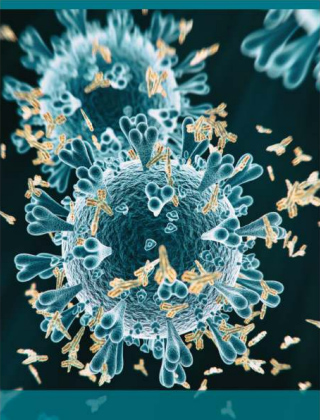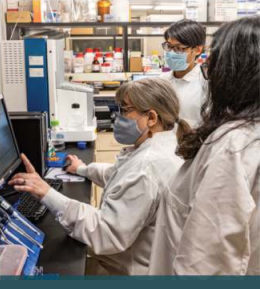Shared Resource Brings State-of-the-Art Molecular Interaction Analysis to Drexel

By Christina Hernandez Sherwood
When Elias Haddad, PhD, and Michele Kutzler, PhD, professors of medicine at the College of Medicine, wanted to test their theory that administering an adjuvant with the COVID-19 vaccine would boost the immunization’s durability, they only needed to climb a few floors from their labs to access advanced equipment that would take their study’s precision from good to great. Drexel is home to the Surface Plasmon Resonance (SPR) Biosensor Shared Resource, which offers research services to investigators, using gold-standard detection equipment to study interactions between molecules in great detail.
For Haddad and Kutzler, a close collaboration with the SPR facility was key to their project. “It was very critical for us to have this technology for the success of [our grant],” Haddad says. “This is a unique technology because it tells you the quality of the [immune] response, not only the magnitude. The technology requires unique expertise and equipment, which is available for us.”
The Scientific Story
The collaboration is an example of how researchers can use state-of-the-art technology readily available on campus to bring precision and clarity to their work. “There may be SPR instruments across the city, but the positive thing about having it at Drexel is we spend time with the scientists in [the SPR facility],” Kutzler says. “They’re involved in our research meetings. They go beyond the technical aspect. They help us to think about how to use that instrument and the data generated in our publications and to put together the scientific story.”
SPR technology was developed in the 1990s. Early on, it was used to study interaction mechanisms between proteins and other large molecules, says Irwin Chaiken, PhD, a professor of biochemistry and molecular biology at the College of Medicine and faculty director of SPR technology services. Along with other work over the last two decades, Chaiken has used SPR technology to study interleukin-5, which is key to the development of asthma. That work paved the way for an asthma drug that is now on the market.
By the time the SPR shared resource was established at Drexel in 2020 — through a joint National Institutes of Health grant with the Sidney Kimmel Cancer Center at Jefferson Health — the technology had advanced enough to perform small molecule screening, enabling the detection of interactions between different types of small and large biomolecules with great sensitivity. The shared resource is especially useful for research including structure-based design of therapeutics, drug discovery, vaccine development and testing, and mechanisms of protein formation in pathogenesis and treatment.
“If you look at the sky with the Hubble telescope, you’ll see galaxies in the far universe,” Chaiken says. “Look at the most recent version of the telescope, and you’ll see even more distantly resolved details of the universe. That’s how it is with SPR versus other technologies. There are other technologies that can do antibody mapping, for instance, but they tend to be lower resolution in terms of the potency and characteristics of binding.”

Gabriela Canziani (seated) goes over SPR results with students in the lab. The instrument, an S200 Biosensor, is in the background on the left.
Battling a Pandemic
When the COVID-19 pandemic struck, College of Medicine investigators came to the SPR shared resource facility to test different approaches to combating the virus, says Gabriela Canziani, PhD, who is well-known as an SPR specialist in the field of molecular interactions and who manages the SPR shared resource in Chaiken’s lab. These included projects related to screening compounds to control viral multiplication and developing therapeutics to inactivate the virus before infection. “We were one of the few allowed to work in the lab during the shutdown,” Canziani says.
As vaccine experts working in HIV, Haddad and Kutzler say they were ideally positioned to pivot to COVID-19 vaccine research when the pandemic hit. Seven years ago, Haddad discovered that administering adenosine deaminase-1 (ADA-1), a known molecule in humans and mice that can cause immunodeficiency when it mutates, could help maintain a strong immune response with a trial HIV vaccine. Haddad and Kutzler were confident that the ADA-1 adjuvant would have the same durability-boosting effect when administered with the COVID-19 vaccine.
To test their hypothesis, the researchers injected mice with a DNA COVID-19 vaccine with and without the ADA-1 adjuvant. The SPR technology measured the amount of the antibody that was stimulated in both cases, and found that mice who received the ADA-1 adjuvant with the vaccine had increased amounts and affinities of antibodies made by the vaccine. SPR technology had allowed Haddad and Kutzler to determine not only that ADA-1 had an immune-boosting impact, but exactly what that impact was.
SPR technology also determines the kinetics of a molecular interaction, Chaiken says, meaning the different speeds with which biomolecules bind and break apart. In the COVID-19 study by Haddad and Kutzler, the kinetics refer to how quickly the monoclonal antibody binds, and subsequently dissociates, from the antigen, according to Canziani. “I remember plotting only the dissociation rates for a quick comparison of the two types of vaccination,” she says, referring to vaccination with and without ADA-1. “There was a significant increase of spike-specific antibody abundance in the studies that included ADA-1, when compared to those without ADA-1. In addition, the induced antibodies remained on target longer [in co-vaccination with ADA-1].”
Haddad and Kutzler say they will continue to use SPR technology in follow-up studies. They have since partnered with other researchers to generate and test an mRNA COVID-19 vaccine that incorporates the ADA-1 adjuvant. They are also working to test the ADA-1 adjuvant in non-human primates, both to study the safety of the adjuvant (though it has been used previously in humans to treat children with immune deficiencies) and to assess the immune response in an animal more closely related to humans than mice.
The long-term aim: to develop a new COVID-19 vaccine that incorporates ADA-1 to create a safe and long-lasting immune response in humans. “We are thinking about this goal in the long run,” Haddad says. “The concept is there. The proof of concept is there. Now the question is can you reproduce this in higher animals and can your adjuvant be administered in humans? If not, what is the alternative?”
Vaccination Versus Infection: Gauging Immune Response
Haddad and Kutzler also collaborated with the SPR facility and scientists on another COVID-19 vaccine project, this one using human samples from early in the pandemic to compare the immune response of people who were only infected with the virus, only vaccinated against the virus, or both infected and vaccinated. “We wanted to see if people get a booster, do they have a better response?” Haddad says. “Do they need to get a booster? If people get infected, do they really have to be vaccinated? These are the questions we wanted to answer.”
The researchers used SPR technology to examine qualitative differences in the various immune responses. They found that the affinity of the antibody — its ability to bind strongly — was improved in people who were both vaccinated and infected. “That’s an important finding because it tells you that even if you’re infected, a vaccine will help to establish better immunity,” Haddad says. “At the same time, if you are vaccinated and get infected, that also will bolster your immunity.”
The SPR facility continues to be involved with other COVID-related work, such as screenings, and participates in other collaborations, including an ongoing project on hepatitis B. Drexel researchers and students working on drug discovery, vaccines and other aspects of biological mechanisms can access the SPR technology and scientists. “The main reason why the shared resource exists is to be able to support projects broadly,” Chaiken says. “We know the technology can be helpful for people.”
Back to Top